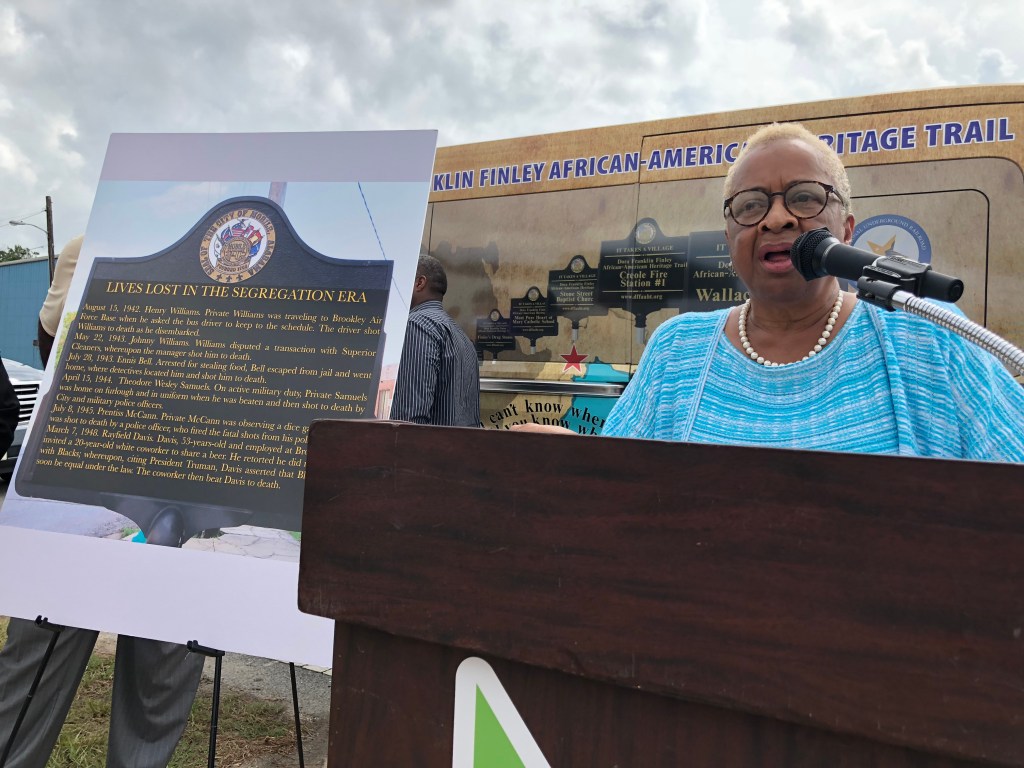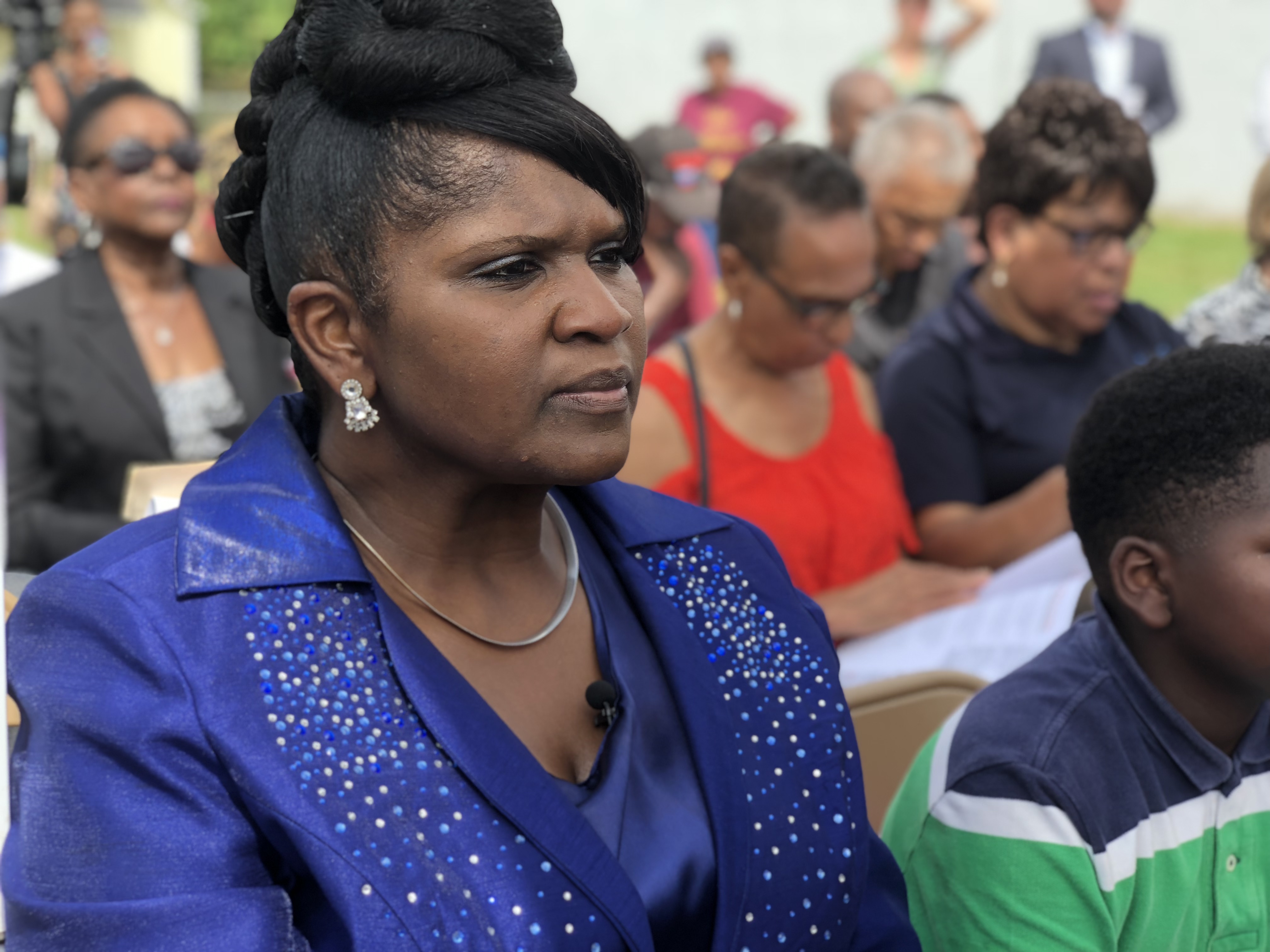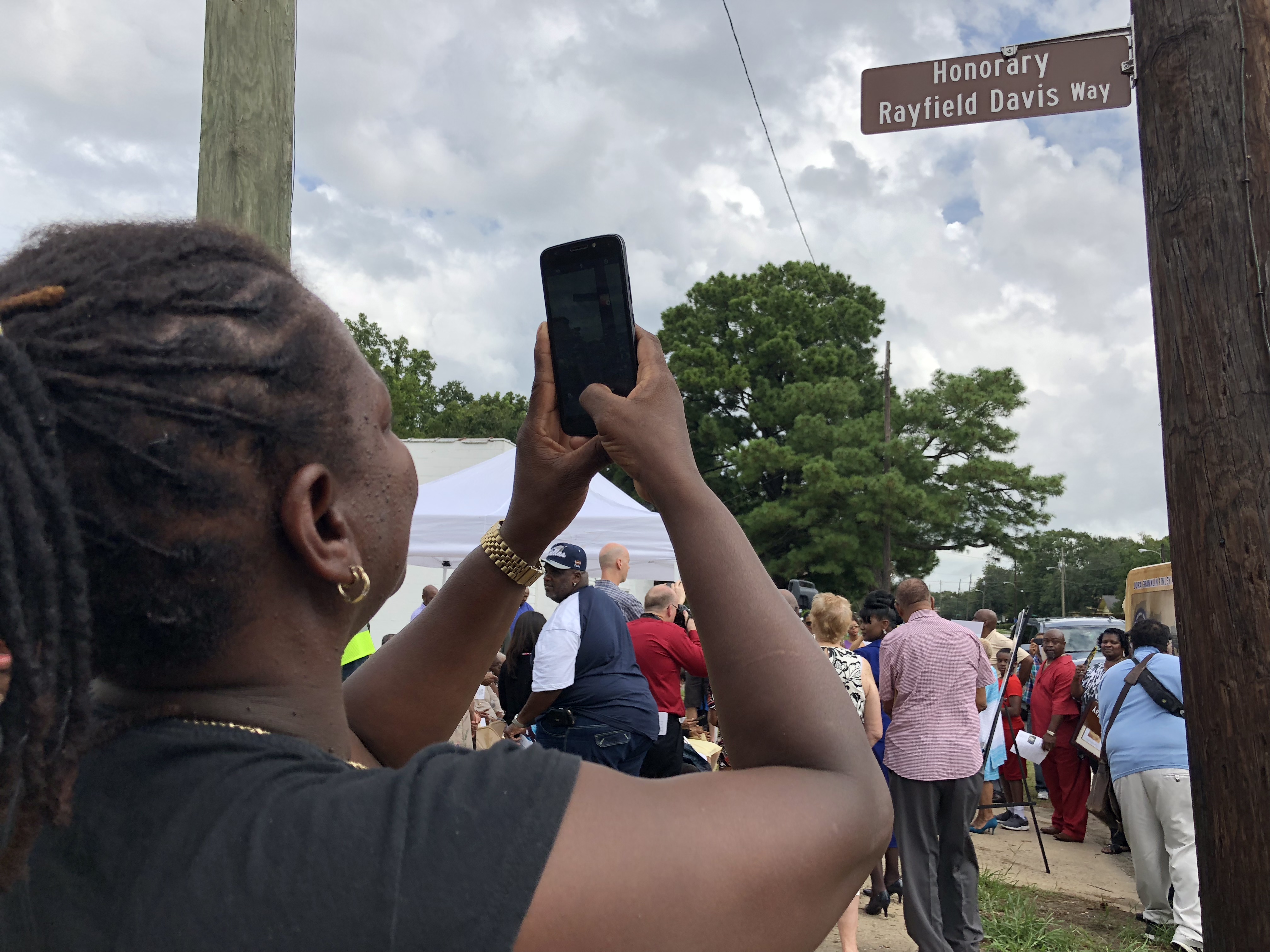After seven decades, Alabama honors Jim Crow-era victims

MOBILE, Alabama—Over these past five years, Rayfield Davis’s descendants have imagined him inviting Horace Miller to join him at his home for a drink. Both men had disembarked at the bus stop on Broad Street after work that fateful day 70 years ago, and Davis’s home was a few minutes’ walk along the railroad tracks.
Davis was a janitor at Brookley Air Force Base hoping to relax at the end of the work day. Miller, 20 years old, turned on Davis, beat him, and left him to be discovered in a ditch. Davis died on his way to the hospital.
“Seventy years ago, he extended courtesy, and he received cruelty as payment,” recalled Tchernavia Moffett, Davis’s generational cousin, from a podium on Saturday near the ditch where his body had been found. “He was murdered, bludgeoned to death, by a white man, for no reason other than the fact that his skin was black and his heart was filled with a dream. Mr. Miller was a dream killer.”
Moffett was one of more than 100 people, including family of the victims, gathered in the thick heat of Saturday morning to honor six black men who had been murdered in Mobile in the 1940s by white men who had not been prosecuted for their crimes. The cold cases had been uncovered, investigated, and brought to light by the Civil Rights and Restorative Justice Project at Northeastern University’s School of Law.
Implicit in the ceremony was a call to action: Several speakers referred to the modern-day cases of Trayvon Martin and other African Americans whose killers have gone unpunished. Mobile police chief Lawrence Battiste, who is black, acknowledged that three of the victims who were honored Saturday had been killed by Mobile police officers.
“I stand here today to offer sincere apologies on behalf of the Mobile police department and the justice system as a whole for our failures to act on these senseless acts of violence that occurred in our community,” Battiste said. “I hope that the words that I say are replicated by our actions as we move forward.”
The ceremony was held a few steps from the deep ditch where Davis, 53, had been beaten to death by Miller, on the edge of a narrow stream that flows alongside the Tennessee Street railroad tracks into the Mobile River. In recent days, another of Davis’s cousins, Nichole Ulmer, had taken to tossing rocks into the stream, to see the water spring up and renew the thick air with a fresh, grassy perfume.

Nichole Ulmer, the great-niece of Rayfield Davis, who was killed 70 years ago. Photo by Benjamin Bertsch.
The Civil Rights and Restorative Justice Project’s investigative staff is made up of Northeastern students. Five years ago, one of them, Chelsea Schmitz, was asked to look into the mysterious 1948 death of Rayfield Davis, based on a single article archived from an African American newspaper. Many of the official documents had been lost to fire, flooding, disorganization, or time. From old newspaper reports and documents, she learned of Miller’s admission that he had been offended by the invitation to a black man’s home and enraged when Davis then predicted that President Harry Truman would deliver equal rights.
“He had died after asserting to a white man that President Truman would improve the lives of African Americans and make their lives better,” said law professor Margaret Burnham, founder and director of the project. “That was a political statement. It was a statement of resistance. It was a statement of dignity and a call for respect. For that, the man to whom he made that statement killed him right here.”
Miller turned himself in for arrest. His open confession was read by his lawyer to the all-white grand jury, which declined to indict Miller.
In an interview before Saturday’s ceremony, Battiste suggested that Miller, now 90, may yet be prosecuted for the murder. But Burnham said this would be highly unlikely, as the only surviving evidence is Miller’s statement of confession, which would not be admissible in court.
The focus Saturday was on another kind of justice, based on understanding and healing. The Northeastern group has investigated and archived 500 acts of racial injustice that took place in the South from 1930 to 1970, and Burnham anticipated that there are another 2,000 unresolved cases from the Jim Crow era that resonate with the stories that were recalled at the ceremony by project investigators and the victims’ families.
- Johnny Williams was killed at a dry cleaner, while reaching into his pocket for a receipt, in a disagreement with the business owner.
- Private Henry Williams, in uniform, was riding a bus to Brookley Air Force Base in Mobile, when the driver stopped to speak with a colleague. “Mr. Williams had the audacity to tell the driver, ‘I have to meet a curfew,’” said Burnham, University Distinguished Professor of Law. “The driver got up, beat him up, and chased him off the bus. He shot and killed him on a street in Mobile.”
- Ennis Bell was being transferred from the city jail to the county jail when he escaped. He was shot and killed in the backyard of his home by Mobile detectives after having been arrested for allegedly stealing potatoes and eggs from a grocery truck.
- Private Wesley Samuels was harassed and assaulted by military and Mobile police officers and was shot dead while trying to flee.
- Prentiss McCann, a father of three, was walking to the grocery store for a bottle of milk when he stopped to watch a dice game. Police arrived to arrest the gamblers. McCann was shot dead by a Mobile officer from his car window.
“After five days, my mother finally realized he wasn’t coming home,” recalled his son, Claude McCann, who said his mother was 19 at the time. “Somebody finally got the nerve to knock on her door and tell her her husband was killed. Five days.
“People have mentioned Trayvon Martin,” Claude McCann went on. “I say I’m sorry to hear about that. The only difference between Trayvon Martin’s death and my father’s death was that Trayvon Martin got a day in court.”

A woman takes a photo of the new street sign that has been installed on Broad Street in Mobile, Alabama, in honor of Rayfield Davis. Photo by Benjamin Bertsch.
The families of the victims who were commemorated on Saturday had known little to nothing of the facts until they were notified by the Northeastern researchers. Nichole Ulmer had never heard the name of Rayfield Davis, even though she had grown up in a house on the railroad tracks next door to his razed property. She and her young relatives grew up swimming and catching crawfish and frogs in the stream. And so she spent the past five years trying to learn everything she could of Davis and to persuade the city of Mobile to commemorate his death.
“It’s a day of sorrow and mourning for a family member we never got a chance to meet in person,” Moffett said. “But because as little kids we played in that ditch, and his blood flowed through that ditch, we were touched by his life as we played in that ditch.”
Ulmer gave three reasons for thanks on Saturday. The first was the health of her 10-year-old son, Terrance, who had been given a 40 percent chance of surviving the stage four neuroblastoma that had been diagnosed just as Ulmer was learning of Davis. Terrance, who has been in remission for three years, was with her at the ceremony.
Second was the new street sign that had been installed above the ditch, on Broad Street, proclaiming the path along the railroad tracks to be known as Honorary Rayfield Davis Way. A historical marker telling the stories of Davis and the other five victims will be erected at the site in the months to come. Ulmer had lobbied for five years for these measures of official respect to be paid.
And third was the letter she read aloud from Nichole Miller-Moreland, granddaughter of Horace Miller. She had learned of her grandfather’s crime only recently, by way of an article in The Washington Post. In phone conversations, it was revealed that Miller-Moreland and her sister had both married black men.
“I try to be the best role model I can be for my siblings, my husband, and our daughter Janea,” she wrote in a letter that was read aloud by Ulmer. “May your family rest in peace now, as all of you are aware my grandfather’s offspring, and their offspring followed by their offspring, do not share the same racial viewpoints.”






